
The CIA (Central Intelligence Agency) is America’s premier intelligence service, under the Federal government tasked with gathering and analyzing overseas intelligence information. We all know this agency well for indomitable spies, covert operations, and movies like Argo (2012). Since its inception in 1947, the CIA has undertaken numerous investigations, projects, and missions, aimed at gathering information to further scientific development and develop precautionary measures. Due to the nature of the missions, which usually involve large amounts of skillfulness and subterfuge, the brave souls that carried out these operations largely remain unveiled and unthanked.
However, the CIA Fine Arts Program maintains a beautiful collection of artworks commemorating a few of these significant successful missions. This collection also contains a large portfolio of historical sculptures, paintings, and other pieces that depict and honor the deeds of intelligence officers in times of peace and war. Here are 7 paintings from the CIA’s Intelligence Art Collection, created to honor some of the great agents and their contribution.
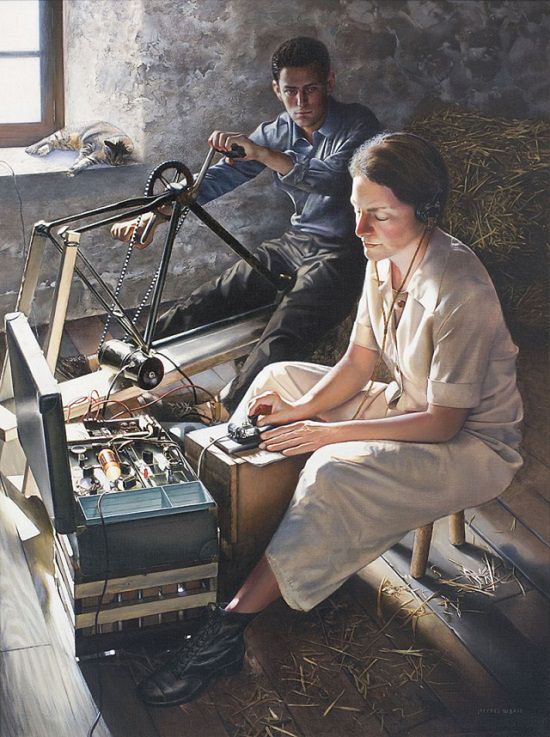
(By Jeffrey W. Bass, Wikimedia Commons)
This painting depicts Virginia Hall, one of the most renowned intelligence officers in the world. After a long stint as a clerk and then having her left leg amputated as the result of an accident, she joined the British Special Operations Executive (SOE) in the 1940s and was placed undercover in France. She spent nearly one and a half years there, gathering intelligence for supply drops, training new agents, and ensuring their safe return to England.
She finally left France in November 1942, after being betrayed and placed on the list of targets of Klaus Barbie, known as the “Butcher of Lyons”. However, a later mission with the Special Operations Branch of the Office of Strategic Services landed her back in occupied France, identifying drop zones and counting troops for the coming Allied invasion.
In the above painting, Hall sits in an old barn near the commune of Le Chambon Sur Ligon, radioing London for supplies on a radio powered by an old generator that was rigged to a discarded bicycle to keep it turning. “Les marguerites fleuriront ce soir” (the daisies will bloom at night) was one of many coded messages that appraised Hall of when and what airdrops would be made. Hall was the only civilian woman to receive the Distinguished Service Cross and later went on to work for the CIA.
In 2006, nearly 25 years after her passing, this painting was unveiled at the Washington DC Residence of French Ambassador Jean-David Levitte, along with a letter from the French President Jacques Chirac, who stated she was a “true hero of the French Resistance”. He also said, “On behalf of her comrades in the Resistance, French combatants, and all of France, I want to tell her family and friends that France will never forget this American friend who risked her life to serve our country.”
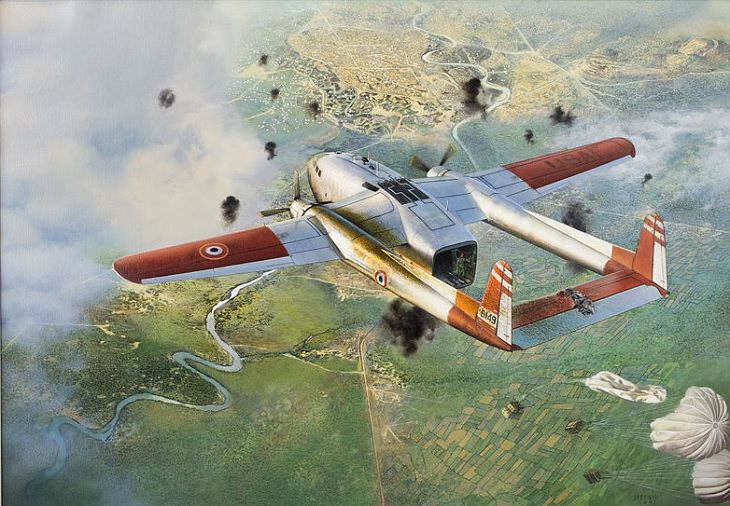
(By The Central Intelligence Agency, Wikimedia Commons)
During the final days of the Indochina war when French troops were suffering heavy losses against the Viet Minh, numerous operations were carried out by Agency proprietary, Civil Air Transport to aid French forces at the Battle of Dien Bien Phu in 1954. With the help of 37 CAT volunteer pilots, using Fairchild C-119 airplanes, with French Air Force roundels painted over U.S Air Force markings, missions were embarked upon to airdrop supplies to struggling French soldiers.
Over nearly 8 weeks, from 13th March to 6th May, 682 successful drops were carried out by CAT pilots across the battle-torn lands, weaving through a sky full of bullets. On 6th May, one of the C-119’s, piloted by CAT legend James McGovern (nicknamed “Earthquake McGoon) and his co-pilot Wallace Buford, was hit by antiaircraft fire. The pilots did their best to keep the plane airborne despite the damage and finally crashed just as it crossed over the border into Laos. The following day, the Viet Minh would break through French defenses.
The painting depicts the plane just as it is hit, hovering over the intended drop zone, a French Garrison code-named “Isabelle”. Both pilots and 2 French Paratrooper passengers were killed in the crash, marking the first American casualties in the Indochina conflict. The crash site was discovered in 2002 and their bodies were discovered. After DNA confirmation of his identity, McGovern was buried with honors in Arlington Cemetery in 2007, and pieces of the airplane are on display in the CIA Museum Collection.
In 2005, at the home of French Ambassador Jean-David Levitte, the Légion d’Honneur, the highest honor of the French Republic, was awarded to five out of the six CAT pilots surviving for their heroic efforts during the conflict.
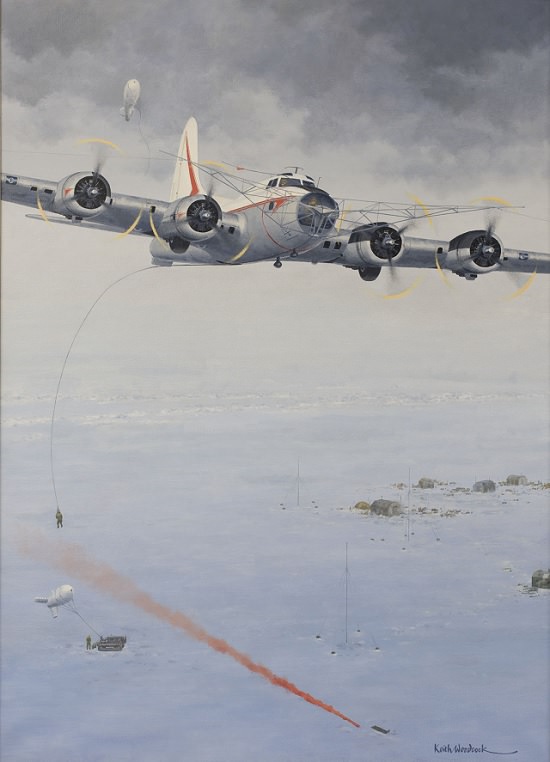
(Flickr)
For the United States and the Soviet Union, the Cold War was a race, a competition to grab every possible advantage over each other. One such treasure sought after by both sides was the Arctic, studies of which could hold much strategic value. In 1962, when a Soviet Drift Station built on an ice island in the Arctic was faced with shifting ice, it rendered their airplane runway useless and the base was abandoned. A disappointment for the Soviet Union, but an opportunity for American Intelligence Forces.
In May 1962, A seven-day mission was embarked upon, entitled Project COLDFEET, to collect all information and equipment left behind on this abandoned Soviet drift station. The plan involved parachuting specialists onto the drift station and then using a unique apparatus, Robert Fulton's Skyhook to retrieve both the specialists and the recovered materials, without landing the plane. Though the device had been thoroughly tested, this was its first instance of operational use.
On 28th May, the creators of the plan, US Navy Lieutenant Leonard LeSchack, and Air Force Major James F Smith were dropped onto the site by a B-17 plane belonging to a CIA Proprietary named Intermountain Aviation, flown by two of the company's pilots, and the company's crew. On June 2nd, despite high winds and weathered visibility, 3 successful passes were made with the Skyhook, retrieving the men and the information.
The information collected during this venture revealed the Soviet Union's extensive research into the detection of US submarines under the ice, as well as plans for the development of Arctic-based techniques on anti-submarine warfare.
In 2008, this painting depicting the B-17 and the Skyhook was unveiled in the headquarters of the CIA. The team that carried out the operation were brought together again for the first time in 46 years, and their achievements were finally revealed to and recognized by their families and friends.
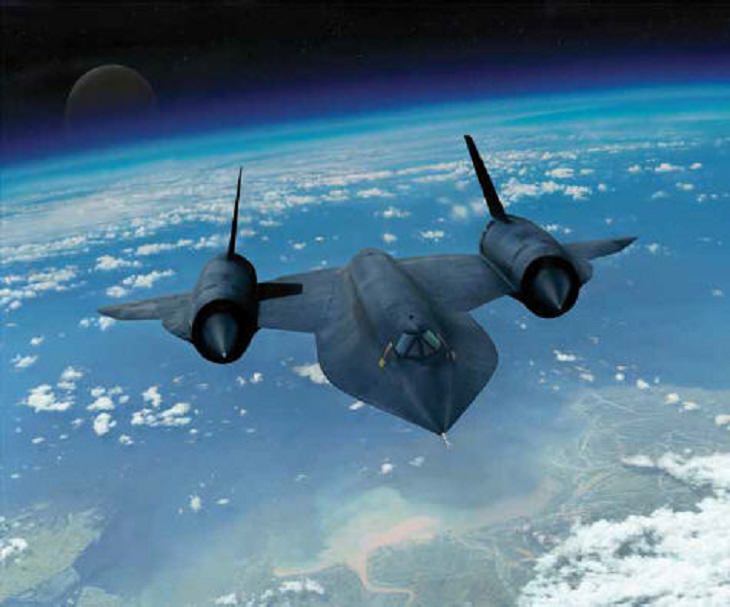
(By The Central Intelligence Agency, Wikimedia Commons)
At the top of the list of significant information to be gathered by intelligence agencies, particularly during the time of the Cold War, was what weapons and strategies the Soviet Union possessed. The first aircraft built to gather this intelligence was the Lockheed U-2, in 1956, also known as the Dragon Lady, and arguably one of the most famous spy planes ever made. Despite its effectiveness in reconnaissance, higher altitudes and faster speeds would be required to truly achieve the intended purpose.
In 1957, the CIA refocused its efforts into creating a new aircraft, which was then named the Lockheed “Skunk Works”- designed A-12, OXCART. Only 15 of these aircraft were built, out of which only 3 were used for operational missions. Depicted in the painting on its first operational flight on 31st May 1967, the A-12 OXCART, this one given the name Article 131, took off from an airbase in Okinawa amid heavy rain. The pilot, Mele Vojvodich, followed the mapped route at a speed of Mach 3.1 and an altitude of 80,000 feet, crossing North Vietnam and refueling in Thailand before touching ground once again at Kadena Airbase in Okinawa.
Though none of these planes were ever flown over Soviet Union airspace, this incredible vehicle was used in 29 operational missions over East Asia, providing key intelligence on installations in North Vietnam, as well as ascertaining that there were no surface-to-surface missile threats in the south and determining the location of the intelligence ship USS Pueblo, which had been seized by North Korea. These operations were jointly classified as Operation BLACKSHIP.
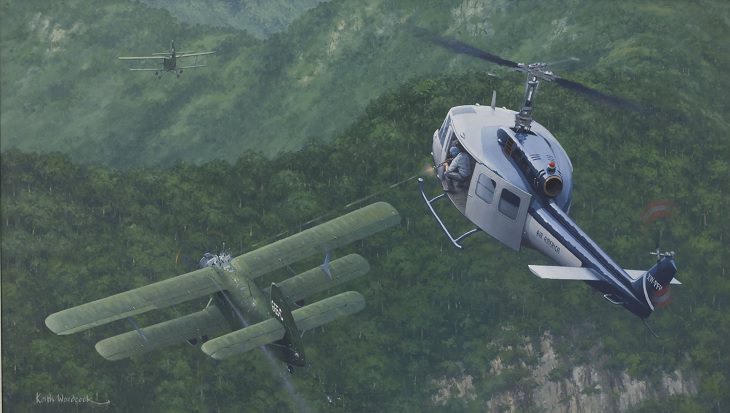
(Flickr)
This painting depicts a moment from history that is made for the movies, filled with heroism, victory, and loss. It began on the morning of 12th January 1968, when 4 AN-2 Colt biplanes, belonging to the North Vietnamese Air Force [NVAF], headed toward Laos on a mission to take out a U.S radar facility that was guiding targeted bombings in North Vietnam. The facility, which sat atop the 6000-foot mountain, Phou Pha Thi, was called Site 85 and was run by U.S Air Force volunteers disguised as Lockheed Aircraft Corporation employees and supported by CIA proprietary, Air America.
By afternoon, the 4 Colts had made their way to the base, and two began bombing the site. By sheer coincidence, the attack was seen from afar by Captain Ted Moore, a pilot for Air America that was on his way to the site with ammunition and had been nearby in a UH-1D Huey helicopter when the onslaught began. Moore began to chase one of the Colts and hovered above it. Glenn Woods, a member of the crew, took up an AK-47 from their cargo and fired down at it.
For 20 minutes, the firing continued, even as a second plane took up airspace under the helicopter. The first Colt went crashing into a ridge and shortly after, the second plane crashed into the side of a mountain. The other two escaped, but this marked a singular aerial distinction for the pilot and crewman, who gained much distinction for shooting down Vietnamese planes with a rifle from a helicopter.
Though this initial mission was partly unsuccessful thanks to the efforts of Ted Moore and Glenn Woods, two months later, North Vietnamese forces launched a successful attack which resulted in the Vietnam War’s deadliest single ground loss of personnel for the U.S Forces.